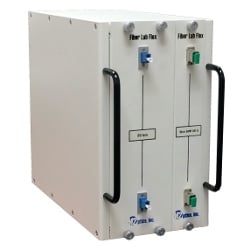Learning to operate an OTDR properly is a critical skill for field technicians managing and servicing fiber optic networks. The OTDR is used frequently to determine length and loss characteristics, including testing optical fibers for faults and related issues that can negatively affect network performance.
There are a number of excellent OTDR devices available in the market, from small portable units designed for field use, to sophisticated laboratory-grade devices that can provide a wide range of features intended for advanced users. Regardless of the type of OTDR itself, the one complimentary training item that is always required is a length of test fiber. (Note: An OTDR launch fiber may also be required for overcoming the “dead zone” of a fiber-under-test, which is discussed here). More importantly, the length of fiber should include issues or "events" to be identified by the device, simulating real-world factors in the classroom.
While most training facilities use unsecured fiber spools on the desktop, this is generally not a best practice, as the delicate fiber is frequently at risk of damage during handling. Since the fiber will be used by many students over time, it is a benefit to both the instructors and the students to utilize a more professional setup designed to protect the fiber and provide consistent results.
By utilizing a Fiber Lab solution from M2 Optics, a number of benefits can be realized that are not available when using a traditional, unsecured fiber spool. For convenience, we have outlined a number of key benefits below.
Key Benefits of Using a Fiber Lab for OTDR Training:
-
Easy-to-handle, professionally-designed enclosures protect fiber from accidental damage while providing consistent results
-
Any types or custom lengths are available, enabling a wide array of real-world scenarios, especially when combining multiple spools
-
The fiber can include in-line events representing field splices, connectors and patch panels, or other factors that affect performance.
A Fiber Lab offers both a training facility and it's students the opportunity to bring the field network right into the classroom for practical, hands-on experience. For the instructors, it is a great value to have a useful tool that can be used for teaching demonstrations and tests, while ensuring that students have learned the OTDR skills necessary to be successful in the field.
 |

|





